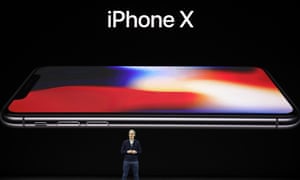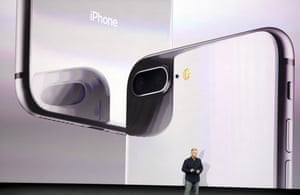Apple event: iPhone X, 8 and 8 Plus release dates revealed – as it happened
Everything announced today
So, from top to bottom:
- The Apple Watch Series 3 ships on 22 September. $329/£329 without cellular connection, and $£399 with.
- The Apple TV 4k ships on 22 September, at $£179.
- The iPhone 8 starts at $£699 for 64GB and the iPhone 8 plus $£799, shipping on 22 September.
- And the iPhone X (that’s “iPhone Ten”, if you want to be one of those people who calls a gif a jif) starts at $£999 for a 64GB model, rising to an astonishing $£1,149 for the 256GB version, and will be available for pre-order from 27 October, shipping on 3 November.

iPhone X
It looks like we knew it would look like: a huge screen taking up the whole front with a, er, 5.8 inch OLED “super retina display”; a glass back; a dual camera; and a small bump cutting in to the top of the screen.
With no home button, the display is enabled simply by tapping on the screen, you get back to the home screen by swiping up from the bottom, and you get to multi-tasking by swiping up and pausing. The side-button is now dedicated to Siri.
What about TouchID? It’s been replaced with “Face ID”. It’s “the future of how we unlock our smartphones”, Schiller says – and it’s based on the front cameras, which are more than just a camera. Seven separate sensors are packed into that little band at the top, and it’s how the company hopes to overcome flaws with previous face unlock systems. It also works at night.

Schiller also reveals what the “bionic” label is on the A11: it’s the neural engine, a subset of the chip dedicated to neural network processing, and that’s how Face ID works. The company even trained its system on professionally made masks, to make sure that it only works on real faces.
More importantly, Schiller says it “requires user attention”, such as looking at the camera, to unlock – so hopefully a pickpocket won’t be able to wave your phone in front of your face then dash off.
“The chance that a random person in the population could unlock your iPhone X and unlock it with their face is one in a million”, Schiller says, comparing it to one in 50,000 for TouchID. But unlike TouchID, it can get confused more easily if someone looks similar to you. If you have an evil twin, “set a passcode”, he says. It works with everything else TouchID does, including Apple Pay.
The neural engine has one other use: terrifying animated emoji. I never want to receive one. Wow. I’m shaken.
Craig Federighi comes onstage to demo the phone.
Wireless charging
Schiller’s not done yet, and he returns to announce the biggest change coming to the iPhone 8: wireless charging.
The iPhone 8 and 8 Plus will now support the Qi wireless charging standard – that’s the one which is built into a lot of IKEA furniture. You’ll soon be able to charge your phone by just leaving it on your bedside table. Hooray!
The iPhone 8 will start at 64GB, from $699, and the 8 Plus will start at $799. Pre-orders from 15 September, available from 22 September, and iOS 11 will be released on 19 September.
iPhone 8
Phil Schiller comes up to talk, but don’t get too excited: it’s the iPhone 8. It looks a lot like the iPhone 7, but it’s now all-glass, and it comes in three colours (silver, grey and rose gold).
There are some new features in this phone, including the True Tone tech carried over from the iPad (it adjusts for the temperature of the light), louder stereo speakers and a new “A11 bionic” chip, but you can tell we’re all rushing through to get to the good stuff.
Still, we should make the most of it while we’re here. Apple’s also showing off its first ever fully in-house GPU (after it broke with Britain’s Imagination Technologies), and a new image signal processor – the brains behind the camera – with noise reduction and faster low-light autofocus.

The camera itself gets a new sensor and new colour filter on the normal 8, while the 8 Plus gets two new sensors for its two new cameras, and the telephoto lens gets better in low light.
But it’s the software where the cameras are getting impressive changes: the 8 Plus can now use the two cameras to build a depth map of a portrait photo, and artificially alter the lighting of the images.
Schiller also calls the iPhone the first phone “designed for Augmented Reality” (that doesn’t sound true, given Google’s Project Tango was explicitly just that, but hey), and shows some AR apps, like a Warhammer game and a baseball analytics app.
Games developer Alti Mar, from Directive Games, arrives to show a multiplayer AR tower defence game. It looks like quite an annoying way of playing a game, but maybe I’m just lazy.



No comments:
Post a Comment